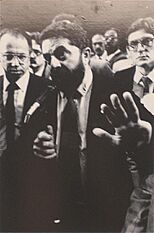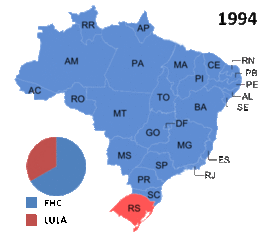Workers' Party (Brazil) facts for kids
Quick facts for kids
Workers' Party
Partido dos Trabalhadores
|
|
|---|---|
 |
|
| Abbreviation | PT |
| President | Edinho Silva |
| Vice President | Washington Quaquá |
| Honorary President | Luiz Inácio Lula da Silva |
| Founded | 10 February 1980 |
| Registered | 11 February 1982 |
| Headquarters | |
| Newspaper | Focus Brasil |
| Think tank | Fundação Perseu Abramo |
| Student wing | Juventude do PT |
| Membership (2024) | |
| Ideology |
|
| Political position |
|
| National affiliation | Brazil of Hope |
| Regional affiliation | São Paulo Forum COPPPAL |
| International affiliation | Progressive Alliance For the Freedom of Nations! |
| Colors | Red White |
| TSE Identification Number | 13 |
| Governorships |
4 / 27
|
| Mayors |
252 / 5,570
|
| Federal Senate |
9 / 81
|
| Chamber of Deputies |
67 / 513
|
| Mercosur Parliament |
7 / 38
|
| State Assemblies |
118 / 1,024
|
| City Councillors |
3,130 / 56,810
|
| Party flag | |
 |
|
|
^ A: A broad left-wing faction, it includes some far-left factions. |
|
The Workers' Party (in Portuguese, Partido dos Trabalhadores, or PT) is a major political party in Brazil. It is considered a centre-left party, which means it supports social progress and government help for citizens. Currently, it is the ruling party of Brazil.
The party was founded in 1980. From 2003 to 2016, it led the government by working with other parties in a coalition government. One of its most famous members is Luiz Inácio Lula da Silva, who served as president and was very popular. Another member, Dilma Rousseff, was also elected president twice. She did not finish her second term because she was removed from office in 2016 through a process called impeachment. The party returned to power when Lula won the presidential election in 2022.
For many years, the Workers' Party and the Brazilian Social Democracy Party (PSDB) were the main rivals in Brazilian politics. From 1994 to 2014, the presidential elections were always a contest between these two parties.
The party's symbols include a red star with "PT" in the middle and a red flag. People who support the party are often called "Petistas."
Contents
How the Party Began
The Workers' Party was created on February 10, 1980, in São Paulo. It was formed by a diverse group of people who were against the military government that ruled Brazil at the time. This group included union leaders, thinkers, artists, and religious leaders who believed in helping the poor.
The party grew out of big worker strikes in the late 1970s, led by people like Luiz Inácio Lula da Silva. These workers wanted to form their own political party to represent their interests, separate from the government and other older parties.
PT was officially recognized as a party in 1982. Some of its first members were famous thinkers and writers, like Antonio Candido and Sérgio Buarque de Holanda.
The Party's Ideas and Beliefs
When the Workers' Party started, it had very strong socialist ideas. For example, it wanted big changes like land reform to give land to more people and government control over banks.
Over time, the party's ideas became more moderate. By the time Lula ran for president in 2002, the party had shifted its focus. It promised to work on improving the economy and making life better for all Brazilians, which is closer to social democracy. This means the government plays a key role in providing services like healthcare and education, while still having a market economy.
The party has also been strongly influenced by a movement in the Catholic Church called liberation theology. This movement focuses on fighting poverty and injustice. Many of the party's early supporters and organizers came from Catholic communities that wanted to help the poor. This connection helped the party grow across the country.
History in Elections
The Workers' Party started winning important elections in the late 1980s. It won control of major cities like São Paulo and Porto Alegre. In Porto Alegre, the party was known for creating new ways for citizens to participate directly in government decisions.
Presidential Races
- 1989: Lula ran for president for the first time. He made it to the second round but lost to Fernando Collor de Mello.
- 1994 and 1998: Lula ran again but lost both times to Fernando Henrique Cardoso of the PSDB party. During this time, PT grew stronger in the national government.
- 2002: After years of trying, Lula won the presidential election. This was a huge victory for the party.
- 2006: Lula was re-elected with over 60% of the vote.
- 2010: The party's next candidate, Dilma Rousseff, won the election. She became Brazil's first female president.
- 2014: Dilma Rousseff was re-elected for a second term.
- 2018: The party's candidate, Fernando Haddad, lost the election.
- 2022: Lula ran for president again and won, bringing the Workers' Party back to power.
Where the Party Gets Its Support
Since 2006, the Workers' Party has received most of its votes from the North and Northeast regions of Brazil. These are some of the poorest areas in the country. Many people there support the party because of its social programs that help low-income families.
The party has had less support in states like São Paulo. However, it has strongholds in other important states like Minas Gerais and Rio Grande do Sul.
The party is often accused of using the differences between the richer South and the poorer North to get votes. The party denies this and says its opponents do the same thing in other regions.
Polls show that the party is very popular among the poorest Brazilians, as well as among Catholic, Black, and mixed-race voters.
How the Party is Organized
The Workers' Party has leaders at the local, state, and national levels. These leaders are elected by party members. The party is made up of many different groups, or factions, with a range of ideas from the centre-left to more socialist views.
Party Presidents
The party has had several presidents over the years. Some of the most well-known include:
- Luiz Inácio Lula da Silva (1980–1994)
- José Dirceu (1995–2002)
- Rui Falcão (2011–2017)
- Gleisi Hoffmann (2017–2025)
- Edinho Silva (since 2025)
Images for kids
See also
 In Spanish: Partido de los Trabajadores (Brasil) para niños
In Spanish: Partido de los Trabajadores (Brasil) para niños








